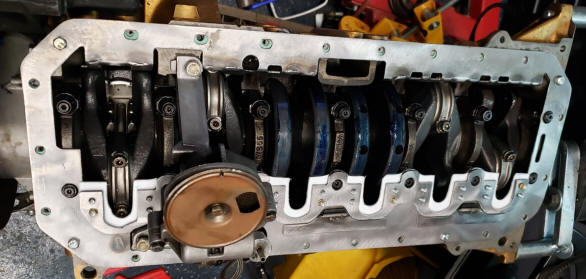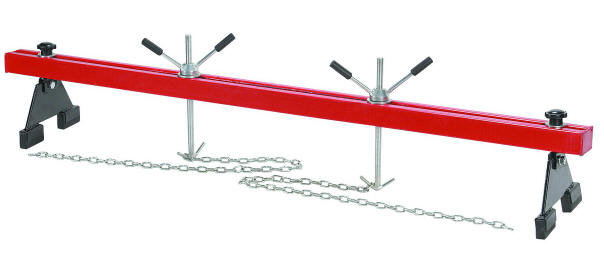Ishihara-Johnson Crank Scraper Installation
The IJ crankscraper is the most common E30 crankscraper solution. It's works fine and it comes in two types, steel and steel/teflon. The former is less expensive but requires a bit of trial-and-error test fitting. Both are a little tricky to install if your engine is already in your car.
What a crankscraper does. In a perfect world, the oil in the sump, the bottom roughly square, forward part of the oil pan, would be a "still volume" of oil. However, the inside of the engine block is a terribly violent place because the spinning crank creates a whirling hurricane of oil. The crankscraper helps strip the oil out of the hurricane so it can more quickly fall to the sump, and the crankscraper helps shelter the oil in the sump from the violence above. Both these measures help the oil pump pickup remain submerged.
Steel IJ scraper.

Steel and Teflon scraper. Note the layer of white material along the bottom working edges of the scraper.
The charm of the steel and Teflon version is that there's no test fitting. When the engine next starts, the crank's counterweights will chew through the Teflon. Scraper and crank will then happily co-exist.
The difficulty of installing the IJ scraper from underneath your car is that
it will keep falling on your face. You put an oil pan gasket on the under-side
of the engine block. Then you place the scraper on the under-side of the block,
just over your face. Then as you reach for another gasket to place on the I-J
scraper, the scraper down on to your head.
The solution is to install the scraper on to the under-side of the block, not
with an oil pan gasket, but with some gasket goobage. Silicon RTV will work, but "high
tack" gasket goobage is better. Once this dries, it will hold the scraper in place
while you put on an oil pan gasket and the pan itself.
Steel scraper (only) task. Modifying the scraper to fit. I've done a couple
of these and they both needed to be modded in order to clear the crank
counterweights. It wasn't even close. There's no getting around the necessary
trial and error. Put the scraper in place using 8-10 of the round holes, turn
the crank a bit and see where the counterweights hit the scraper, mark the
scraper where material needs to be removed, take the scraper off the block and
hit it with an angle grinder.
I don't know what the school solution is for how much clearance is ideal between
scraper and spinning counterweights. I'd aim for 2mm, I suppose.
How to install the scraper. Use some solvent, like brake cleaner or alcohol, to clean the bottom of
the block and the scraper. With the oil pump installed, put a layer of your goobage on the bottom of the block, and then put in 8-10 bolts to make sure the
scraper is precisely located. Be careful not to use bolts that are too long
because some of the holes in the block and tranny don't go too deep and if you
force an over-long bolt, it will bottom out and then strip the hole's threads.
It doesn't take much force for a 6mm hardened steel bolt to destroy cast iron
threads.
|
Use the holes in the scraper that are round, not the larger oval holes. If you
have the steel scraper, you should have already done your test fitting and
grinding on the steel so you have the good fit that you wanted.
Once the scraper is installed, spin the crank a couple times and make goddamned sure
that the crank's counterweights clear the scraper as much as you intended. Then
walk away a while, maybe over-night depending on how fast your goobage is going
to dry. Historically, I've always waited overnight.
Once you think the goobage will hang on to the scraper, carefully remove
the bolts that held the scraper in place. Inspect the lower surface of the
scraper for any goobage on it's lower surface that might impact a good seal with
the pan. Then either use another layer of goobage and put the oil pan on.
Supporting thoughts.
Goobage vs. gaskets. You want the oil pan to ride as high as possible because
this locates the oil pump pickup as low as possible in the pan. The IJ scraper
is a pretty thick piece of steel so it drops the oil pan and therefore
effectively raises the oil pump pickup. Don't make this worse by using a thick
paper oil pan gasket. Minimize the problem as much as possible by using goobage
as your oil pan seal, not oil pan gaskets. The goobage will squeeze out and
you're have metal to metal mating for most of the oil-pan. If you are determined
to use an oil pan gasket, use a thin cork gasket, not the better thick paper
gasket.
How to lift the engine up to get the oil pan off easily. The easy solution is to
use a cheap engine "support bar" from Harbor Freight. Put it in place across
your wheel wells and fasten the chains under your motor mount wings. Unfasten
motor and tranny mounts, then lift the engine up until the top of the tranny
hits it's tunnel.

Harbor Freight Engine Support Bar. $80. Darn handy.
Fastening the oil pump in place. Cleaned the bolts and 3 holes with brake cleaner, let the stuff dry, then use blue locktite. You can't crank the bolts really tight because the block is cast iron, not hardened steel, but the blue locktite will keep the bolts in place. Don't use red locktite, that stuff is too strong.
A scraper is not a baffle. The purpose of a baffle is to make it harder for
oil in the sump to slosh away from the pump pickup. The location of a scraper,
above the pan, is way too high to act as a baffle. Since you already have
your oil pan off, this would be a really good time to install a baffle, which
imo is a "must do." SpecE30.com has good content re. baffles here
http://www.spece30.com/c/troubleshooting-and-tips/oiling-system